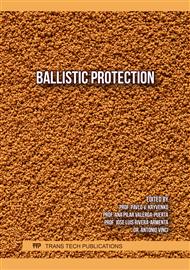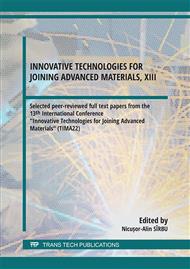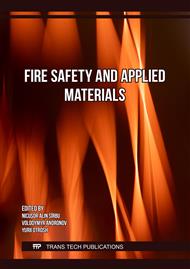[1]
Information on https://www.dupont.com › public › documents: Kevlar® Aramid Fiber Technical Guide – DuPont. Accessed on 01.11.(2022)
Google Scholar
[2]
Information on https://www.clm-pro.com/ballistic-kevlar-aramid-195-g-m%C2%B2-plain-detail?tmpl=component&format=pdf. Accessed on 01.11.(2022)
Google Scholar
[3]
Information on https://www.perrinaquadecoupe.fr/materiauxcarbonekevelar.html. Accessed on 01.11.(2022)
Google Scholar
[4]
Information on https://www.jeccomposites.com/news/composite-repair-and-machining-using-abrasive-waterjet. Accessed on 01.11.(2022)
Google Scholar
[5]
C. Ma and R.T. Deam: A correlation for predicting the kerf profile from abrasive water jet cutting, Exp Therm Fluid Sci 30(4), (2006), pp.337-343
DOI: 10.1016/j.expthermflusci.2005.08.003
Google Scholar
[6]
F. Masoud, S. M. Sapuan, M. K. A. M. Ariffin, Y. Nukman and E. Bayraktar: Cutting Processes of Natural Fiber-Reinforced Polymer Composites, Polymers 12 (1332), (2020), pp.1-17
DOI: 10.3390/polym12061332
Google Scholar
[7]
A. Dhanawade and S. Kumar: Experimental study of delamination and kerf geometry of carbon epoxy composite machined by abrasive water jet, Journal of Composite Materials, Volume 51, Issue 24, (2017)
DOI: 10.1177/0021998316688950
Google Scholar
[8]
T.U. Siddiqui and M. Shukla: Optimisation of surface finish in abrasive water jet cutting of Kevlar composites using hybrid Taguchi and response surface method, Int. J. Machining and Machinability of Materials, 3 (3/4), (2008), pp.382-402
DOI: 10.1504/ijmmm.2008.020970
Google Scholar
[9]
A. Abidi, S.B. Salem and M.A. Yallese: Experimental and Analysis in Abrasive Water Jet Cutting Of Carbon Fiber Reinforced Plastics, 24ème Congrès Français de Mécanique, Brest, (2019)
Google Scholar
[10]
M.A. Azmir, A.K. Ahsan and A. Rahmah: Investigation on Abrasive Waterjet Machining of Kevlar Reinforced Phenolic Composite Using Taguchi Approach, ICME (2007), https://me.buet.ac.bd/icme/icme2007/Proceedings/PDF/ICME07-AM-13.pdf
Google Scholar
[11]
M. Shukla and P. B. Tambe: Predictive modelling of surface roughness and kerf widths in abrasive water jet cutting of Kevlar composites using neural network, Int. J. Machining and Machinability of Materials, Vol. 8, Nos. 1/2, (2010), pp.226-246
DOI: 10.1504/ijmmm.2010.034498
Google Scholar
[12]
N. Sathishkumar, R. Selvam, K.M. Kumar, A.H. Abishini, T. Khaleelur Rahman and S. Mohanaranga: Influence of garnet abrasive in drilling of Basalt–Kevlar–Glass fiber reinforced polymer cross ply laminate by Abrasive Water Jet Machining process, Materials Today: Proceedings 62, (2022), p.1361–1368
DOI: 10.1016/j.matpr.2022.04.861
Google Scholar
[13]
K.Ramraji, K.Rajkumar, M. Dhananchezian and P.Sabarinathan: Key Experimental Investigations of cutting dimensionality by Abrasive Water Jet Machining on Basalt Fiber /Fly ash Reinforced Polymer Composite, Materials Today: Proceedings 22, (2020), p.1351–1359
DOI: 10.1016/j.matpr.2020.01.428
Google Scholar
[14]
J. G. A. Bitter: A study of erosion phenomena, Part I, Wear, 6, (1963), pp.5-21
Google Scholar
[15]
J. G. A. Bitter: A study of erosion phenomena, Part II, Wear, 6, (1963), pp.169-190
Google Scholar
[16]
G. Schuetz: Surface Texture from Ra to Rz, https://www.mmsonline.com/columns/surface-texture-from-ra-to-rz. Accessed on 01.11.(2022)
Google Scholar
[17]
Information on https://www.taylor-hobson.com › files › user-guides: Surtronic 25 - Taylor Hobson. Accessed on 15.05.(2022)
Google Scholar
[18]
D. C. Montgomery: Design and Analysis of Experiments, Fifth Edition, John Wiley and Sons, New York, (2001)
Google Scholar
[19]
D. Taloi: Optimizarea proceselor tehnologice, Editura Academiei RSR, Bucureşti, (1987)
Google Scholar
[20]
Information on https://stattrek.com/online-calculator/f-distribution. Accessed on 01.11.(2022)
Google Scholar




